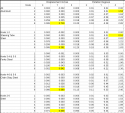billyk
Guru
Back in April we discussed flex between the handlebars and the bottom bracket/pedals of the Quest (http://cruzbike.com/energy-sucking-handlebar-stick). Various people pointed to the handlebar bending, the Diatech headset, etc. John T noted that it is the accumulated flex of the whole system, and that the design of the Silvio/Vendetta is intended to reduce this.
Rich suggested that "As a test, a bar-end could be attached at the top of the riser (right below the handlebars) pointing forward (and angled down) and a pipe stuck on that sticking out forward to a point somewhere near the bottom bracket". A very good idea that I finally got a chance to try.
My setup (see photos) consists of
* The back end of a stem clamped on to the extension tube below the actual handlebar-holding stem. (Bar-ends don't fit on the extension tube)
* A custom mount to hold a 5/8-inch dowel (Rich's "pipe") pointed forward from the stem piece. This is from Brazilian Rosewood (masa randuba) which is an exceptionally hard wood that can be machined much like metal (with sharp tools), and can be drilled to make exact holes like metal. The mount bolts on to the stem and the dowel goes through it.
* A piece of clear polycarbonate is screwed into the front end of the dowel, with tickmarks filed into it. The ticks are 1/2-inch apart, roughly 1 degree at this distance.
* A vertical threaded rod sticks up from the BB, serving as a pointer against the tickmarks. (This rod is part of my fairing; see "new homemade fairing for Quest" http://cruzbike.com/new-homemade-fairing-quest)
This setup reveals any flex from the extension tube below the handlebar to the bottom bracket, separate from handlebar bend.
I've ridden this for about 25 miles, on all kinds of grades. The dowel is surprisingly rigid and it is quite easy to read the deflection of the vertical rod against the tickmarks.
Results expressed as observed *peak-to-peak* deflection in fractions of a tick. I don't claim accuracy of much better than half a tick:
- Riding no-hands: zero
- Maintaining steady speed of 15mph on a flat: up to one-half tick
- Normal acceleration from stop: up to 1 tick
- Hard acceleration from stop: up to 1.5 ticks
- Climbing a shallow grade (2-5%): 1-1.5 ticks
- Climbing a hard grade (about 8% per google maps): 2 ticks (more if in a too-high gear)
- Holding the front brake and pushing the pedal as hard as I could: 1.5 ticks <<== Each side separately (equivalent to 3 ticks of the others)
Thus there is a lot of flex between the extension tube and the BB, aside from anything to do with the handlebars. It makes little difference on the flat, but is a big deal when climbing hard.
To test the handlebar bend, I ran fine steel wire from the brake lever mounts to the end of the dowel, with each one fixed independently at both ends, just less than tight. These sensitively (if not quantitatively) show distance change between either handlebar and the dowel end. That is, if one side of the handlebar was bending back as I pulled, the wire would stiffen visibly. OK, definitely not quantitative but a yes/no test.
I repeated the previous tests. No change in the wire lengths was seen (or felt in tests with the brake held tight while pressing the pedal).
Thus, I conclude that most of the flex is in the boom/slider arrangement, including the pivot clamp at the top of the slider. Very little if any is in the handlebar. Agree?
Now, what to do about this?
I don't want a Silvio or Vendetta because I need the more upright seat of the Q for extensive mixing it up with car traffic, pedestrians, dogs, ..., plus being able to see potholes etc. (Can't afford one, anyway). I'm very happy with the Quest after more than 4000 miles; I just don't want to waste power when I'm climbing hills and need every Watt.
It seems like a longer slider would help, since I now know the length I need and do not adjust it. I seem to remember such being available but don't see it for sale on the web page.
The long slider could be further stiffened with another tight-fitting tube inserted inside it.
Opinions/suggestions welcome!
Billy K
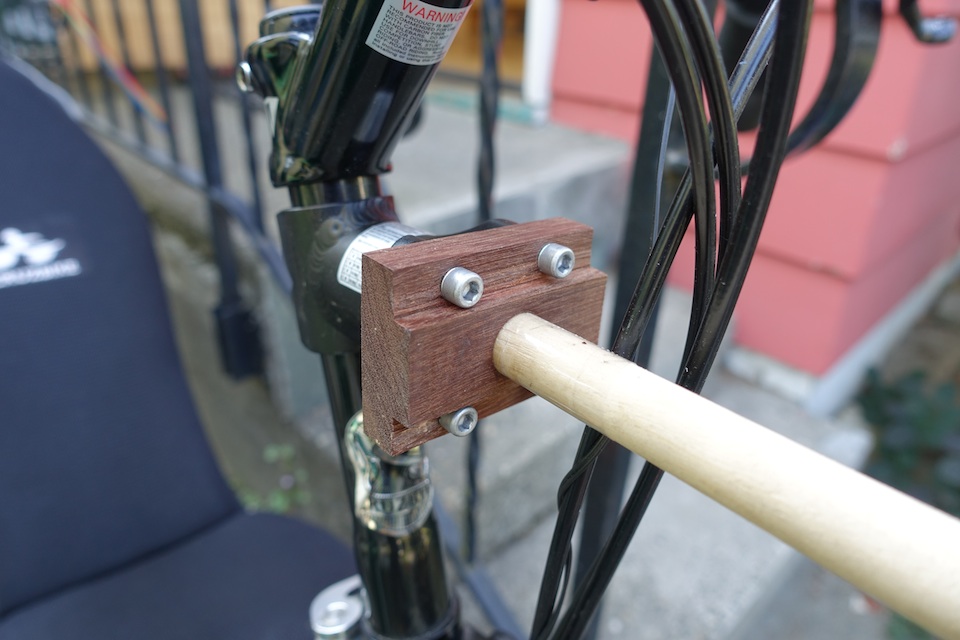
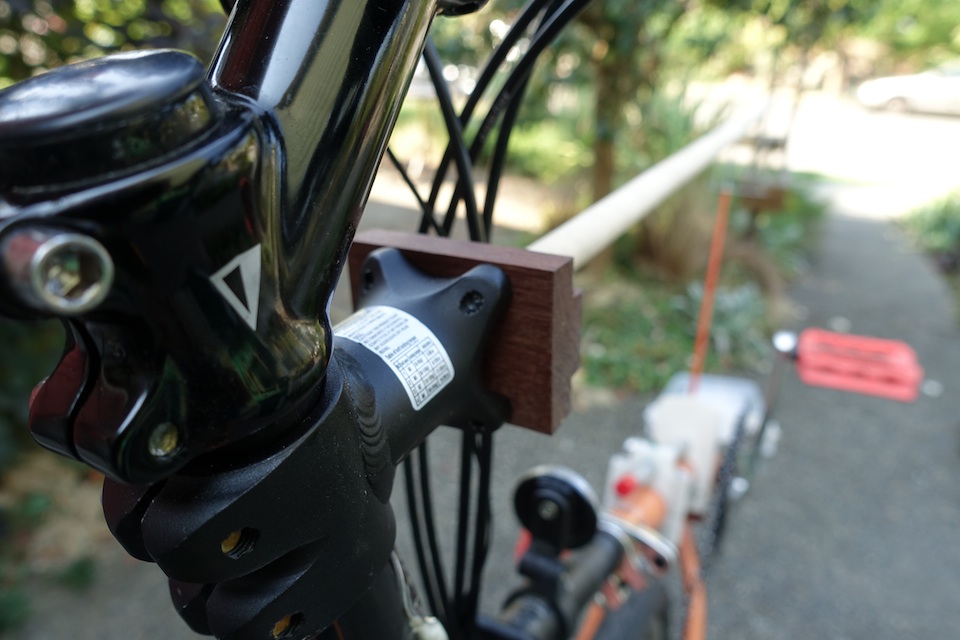
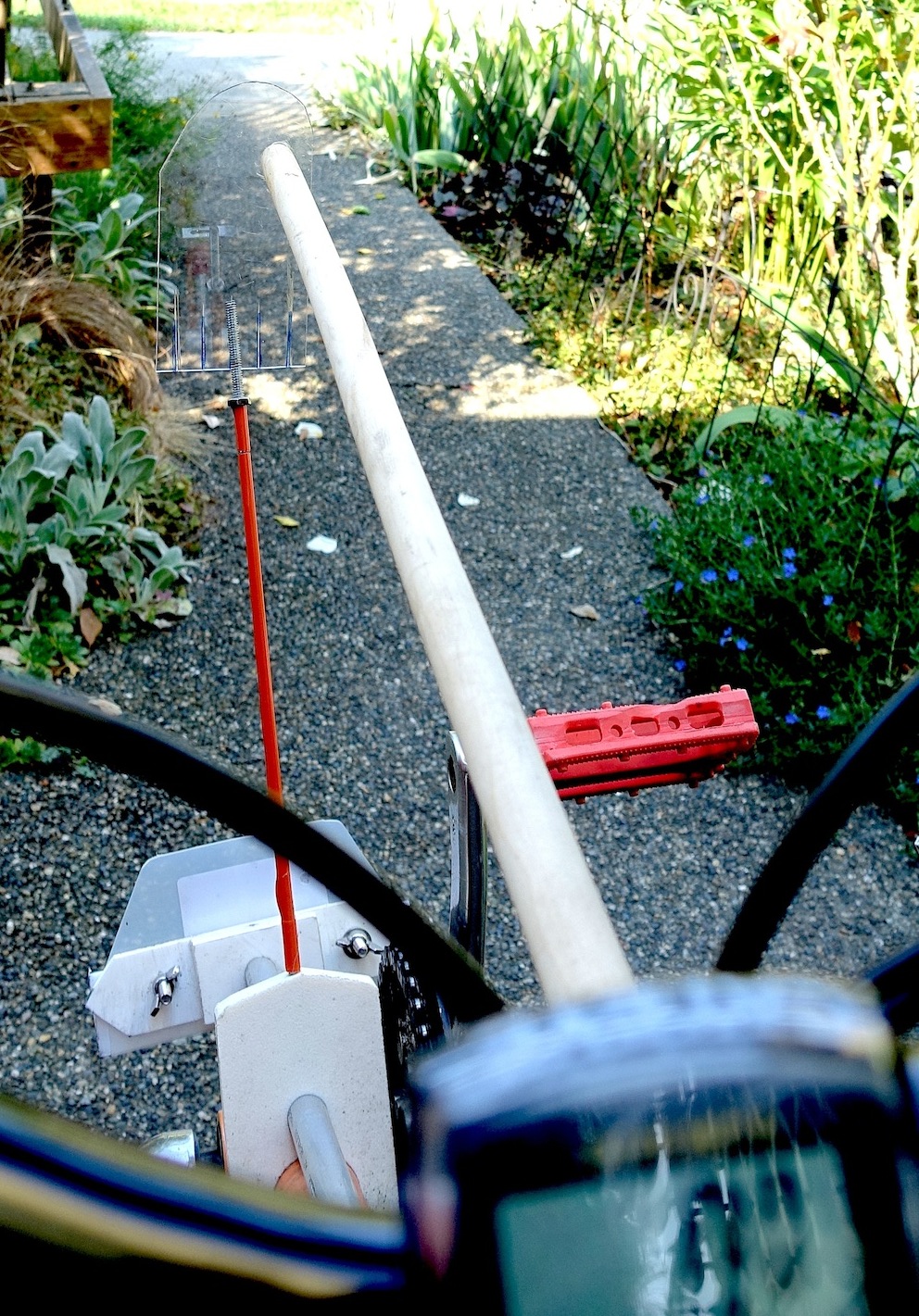
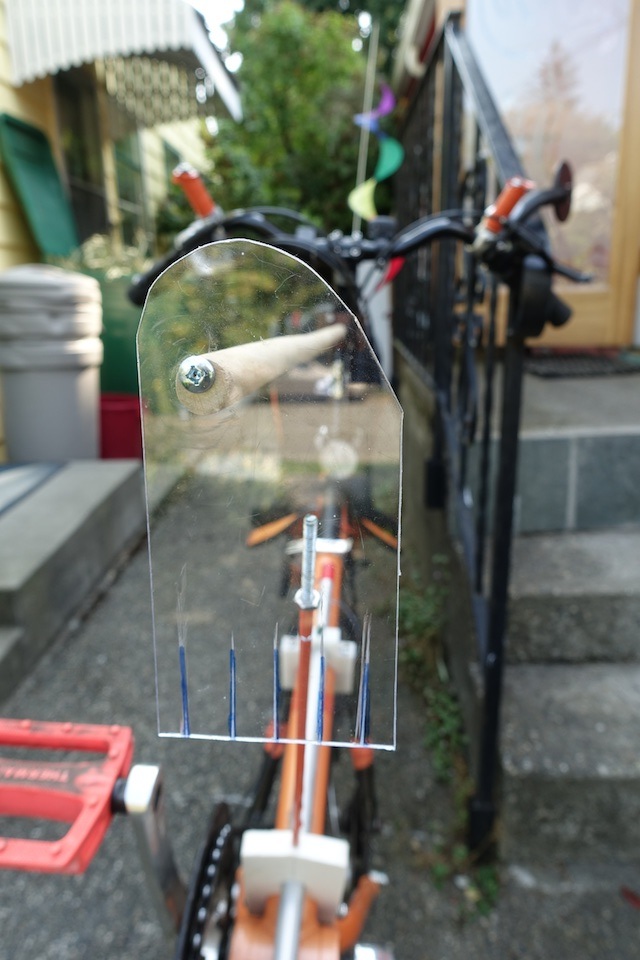
Rich suggested that "As a test, a bar-end could be attached at the top of the riser (right below the handlebars) pointing forward (and angled down) and a pipe stuck on that sticking out forward to a point somewhere near the bottom bracket". A very good idea that I finally got a chance to try.
My setup (see photos) consists of
* The back end of a stem clamped on to the extension tube below the actual handlebar-holding stem. (Bar-ends don't fit on the extension tube)
* A custom mount to hold a 5/8-inch dowel (Rich's "pipe") pointed forward from the stem piece. This is from Brazilian Rosewood (masa randuba) which is an exceptionally hard wood that can be machined much like metal (with sharp tools), and can be drilled to make exact holes like metal. The mount bolts on to the stem and the dowel goes through it.
* A piece of clear polycarbonate is screwed into the front end of the dowel, with tickmarks filed into it. The ticks are 1/2-inch apart, roughly 1 degree at this distance.
* A vertical threaded rod sticks up from the BB, serving as a pointer against the tickmarks. (This rod is part of my fairing; see "new homemade fairing for Quest" http://cruzbike.com/new-homemade-fairing-quest)
This setup reveals any flex from the extension tube below the handlebar to the bottom bracket, separate from handlebar bend.
I've ridden this for about 25 miles, on all kinds of grades. The dowel is surprisingly rigid and it is quite easy to read the deflection of the vertical rod against the tickmarks.
Results expressed as observed *peak-to-peak* deflection in fractions of a tick. I don't claim accuracy of much better than half a tick:
- Riding no-hands: zero
- Maintaining steady speed of 15mph on a flat: up to one-half tick
- Normal acceleration from stop: up to 1 tick
- Hard acceleration from stop: up to 1.5 ticks
- Climbing a shallow grade (2-5%): 1-1.5 ticks
- Climbing a hard grade (about 8% per google maps): 2 ticks (more if in a too-high gear)
- Holding the front brake and pushing the pedal as hard as I could: 1.5 ticks <<== Each side separately (equivalent to 3 ticks of the others)
Thus there is a lot of flex between the extension tube and the BB, aside from anything to do with the handlebars. It makes little difference on the flat, but is a big deal when climbing hard.
To test the handlebar bend, I ran fine steel wire from the brake lever mounts to the end of the dowel, with each one fixed independently at both ends, just less than tight. These sensitively (if not quantitatively) show distance change between either handlebar and the dowel end. That is, if one side of the handlebar was bending back as I pulled, the wire would stiffen visibly. OK, definitely not quantitative but a yes/no test.
I repeated the previous tests. No change in the wire lengths was seen (or felt in tests with the brake held tight while pressing the pedal).
Thus, I conclude that most of the flex is in the boom/slider arrangement, including the pivot clamp at the top of the slider. Very little if any is in the handlebar. Agree?
Now, what to do about this?
I don't want a Silvio or Vendetta because I need the more upright seat of the Q for extensive mixing it up with car traffic, pedestrians, dogs, ..., plus being able to see potholes etc. (Can't afford one, anyway). I'm very happy with the Quest after more than 4000 miles; I just don't want to waste power when I'm climbing hills and need every Watt.
It seems like a longer slider would help, since I now know the length I need and do not adjust it. I seem to remember such being available but don't see it for sale on the web page.
The long slider could be further stiffened with another tight-fitting tube inserted inside it.
Opinions/suggestions welcome!
Billy K






